Policy Choice Impacts on Global Hunger & Climate Change
The continued prevalence of hunger and poverty along with escalating disasters related to climate change are among the most significant socioeconomic problems of this generation. Fortunately, significant policy choices exist that can reduce global hunger and set humanity on a better path toward addressing climate change in the future. Admittedly, global hunger and climate change are incredibly complex issues, and no “silver bullet” can adequately address these long-term challenges. However, a combination of policy changes can be mutually reinforcing and spur the strongest impact. At the same time, wrong choices can result in incoherent policies that undermine the ultimate goal. When electing policies, the ultimate challenge is distinguishing myth from fact with regard to existing options that contribute to global hunger and climate change.
With this in mind, ActionAid USA launched a web game, presidentforaday.com, to demonstrate how current policy choices on climate change, foreign aid, agricultural development and corn-based biofuels will impact the future. Game players take a short quiz that will, in turn, generate a newspaper with headlines illustrative of the outcomes based on those choices. To achieve the best combination – and a newspaper that celebrates the “president’s” success – the web game player must be careful to avoid making choices based on common misperceptions in policy areas. SPOILER ALERT: The content below reveals some of the answers in the presidentforaday.com challenge. Anyone who has not played the game yet may want to do so before reading the rest of the article to see how he/she would “measure up” to addressing the hunger and climate crisis.
Misperception One: Smallholder farmers can’t feed their communities; therefore, increasing industrial production is the answer.
The continued prevalence of global hunger is not the result of a net shortage in food being produced but rather a lack of physical, social and economic access to available supply. People, therefore, should not expect that simply increasing production of food through industrialized, large-scale agriculture will lead to a hunger-free planet. Most of those who do not get enough to eat – more than 870 million people according to the Food and Agriculture Organization of the United Nations (FAO) – are rural inhabitants of developing countries. They are largely dependent on agriculture for their livelihoods, either directly as producers or indirectly as members of farming families or operators of businesses that depend on the sector. These farmers often work on small plots of land and without sufficient access to information, education, resources, credit, transportation and markets.
Women farmers, who comprise approximately one-half of the agricultural labor force in developing countries, often experience these constraints more intensely than men. Simply increasing large-scale agricultural production will not address barriers these smallholder farmers are facing nor does it resolve other challenges in the global food system. One of these is ensuring that food reaches those who are coping with hunger and malnutrition in rural areas. For example, transport of food from distant farms to rural homesteads can be expensive even when infrastructure like roads and storage facilities are in place (which often is not the case). On the other hand, an approach that focuses on removing barriers hindering smallholder productivity, especially for women, can alternatively have an enormous impact on livelihoods and food security. Research shows these productivity gains, when unleashed, spur agricultural sector growth that is particularly effective in reducing hunger compared to growth in other sectors.
Misperception Two: The private sector alone is a “silver bullet” to end hunger and address climate change.
Smallholder farmers in low- and middle-income countries are the largest private sector investors in their own agricultural production and greatly outweigh investments of their own governments, donors and foreign investors in the agriculture sector.1 But, as mentioned above, they often face constraints, which limit the depth and effectiveness of their investments. Addressing these constraints is a necessary role of public sector investment that can get lost with a focus solely on the private sector. For example, agricultural research and development has been identified as a critical public good, which provides strong returns in agricultural growth and poverty reduction. But public investment should not stop there. Smallholder farmers often have very limited or no access to extension services that could teach them how to produce more effectively with available research and resources. Private-sector extension services tend to focus on cash crops and often only reach farmers who are relatively well-off. Greater public investment in farming education for smallholders can have a big impact on productivity. Furthermore, smallholder farmers often do not have financial services available to them, or they are otherwise prevented from accessing credit.

Courtesy of USAID
Easing these constraints can help farmers invest more in their own production.Industrialized countries are also increasingly looking to the private sector to finance climate change mitigation and adaptation in developing countries. Unfortunately, this focus on private finance for climate change is similarly misguided. Decades of experience has proven that private finance fails to reach the poorest communities in developing countries and often bypasses the poorest countries altogether. Given that these communities and countries are the most vulnerable to climate change impacts, this is a severe limitation on the usefulness of private investment for climate finance.Also relevant is the “polluter pays” principle: Emissions from developed countries created the climate crisis, thus these countries bear the greatest responsibility for dealing with the problem, not developing countries, which had little to do with causing climate change. By this principle, climate finance must be provided in the form of grants rather than debt-producing loans. Private investment fails this criterion. The fact that private capital by its inherent nature seeks a return-on-investment means public-sector finance is the highly preferable option for climate finance, particularly for activities like adaptation for the most vulnerable.
Misperception Three: Climate change and agriculture have somewhat narrow linkages.
Agriculture is both a driver and a victim of climate change. Including land-use change and deforestation for agricultural expansion, agriculture is responsible for up to 30 percent of global greenhouse gas (GHG) emissions.2 Meanwhile, climate change impacts are already prevalent as seen by increased instances of extreme weather throughout the world. While no one is immune from climate change impacts, those in developing nations, who have done the least to cause it, bear the greatest brunt.
Misperception Four: Corn-based biofuels are the best answer to meeting energy needs.
In recent years, the United States has shifted toward policies that encourage an artificial demand for corn-based biofuels. In fact, under the Renewable Fuel Standard, 40 percent of corn grown in the United States is now used to produce ethanol. This has put strong upward pressure on corn prices, which have risen sharply in recent years and hit record highs as drought affected production in 2012. Higher prices for corn have encouraged farmers to switch their land away from other food crops, such as soybeans, to produce corn specifically intended for fuel. When the supply of these crops shrinks, prices rise as well. This increase in prices is felt by U.S. and global consumers, especially those living in poverty. Worse yet, while corn-based biofuels are driving hunger, they are not actually benefiting the environment. Studies have shown that the process of creating ethanol from corn produces enough greenhouse gas emissions to offset any gains that could otherwise be obtained from burning corn-ethanol rather than fossil fuels.
Mandates for corn-based biofuels production are increasing in number around the world. The United States produces its own biofuels, but many countries have to look outside their borders to source their food-based fuel. When these biofuels are made from food or other land-intensive feedstocks, it drives one of two problems. Either it exacerbates food insecurity if the displaced food crops are not grown elsewhere, or it forces farmers to convert carbon-rich natural habitats to farm land, thus accelerating climate change. Global food security is a huge price to pay for a policy that isn’t even helping the environment. It is critical for people to consider the impact of energy policies on food supply and environment and forget ethanol.

Courtesy of USAID
Misperception Five: Foreign aid is a drain on the federal budget, and little progress has occurred when compared to costs.
The misguided belief that foreign aid plays a significant role in the federal deficit often drives pressure to slash aid programs, especially during tight fiscal times. However, this idea is short-sighted. In reality, foreign aid accounts for approximately one percent of the federal budget. Since the amount spent is so small, even a total elimination of aid programs would do little to reduce the deficit, but it would have immense impacts on world hunger. Furthermore, no clear indication exists that such cuts represent net savings throughout the long-term. Cutting foreign aid programs that help farmers reach their potential and build resilience in the long-run is likely to increase the need for expensive emergency humanitarian assistance in the future.
Additionally, U.S. programs funded through foreign aid allocations, such as Feed the Future and the multilateral Global Agriculture and Food Security Program (GAFSP), are producing quantifiable results to reduce world hunger throughout the long-term. Therefore, they should be maintained. For instance, farmers interviewed by ActionAid at a GAFSP project site in Rwanda said they realized remarkable productivity gains throughout a one-year period – as much as a six-fold increase for some farmers. These yields are alleviating hunger in their community, and the resulting income is contributing to poverty reduction for the region. But the program is still only partially complete. If the programs are cut now, it would undo much of the progress that has been gained with little benefit to the U.S. budget.
Public Perception and Policy
When it comes to global hunger and climate change, making the right combination of policy choices now will make a world of difference in the future. Americans can’t allow misguided myths to shape their critical decisions. ActionAid USA believes in the power of citizens around the world to influence policymakers and to hold governments accountable for upholding, respecting and supporting human rights. ActionAid USA hopes that the President for a Day game can dispel some common misunderstandings around these complex issues and foster further discussion and action to address one of the defining issues of the time. Humanity is at a crossroads for decision-making, and it is time to step-up to the plate together to make global hunger history.




























